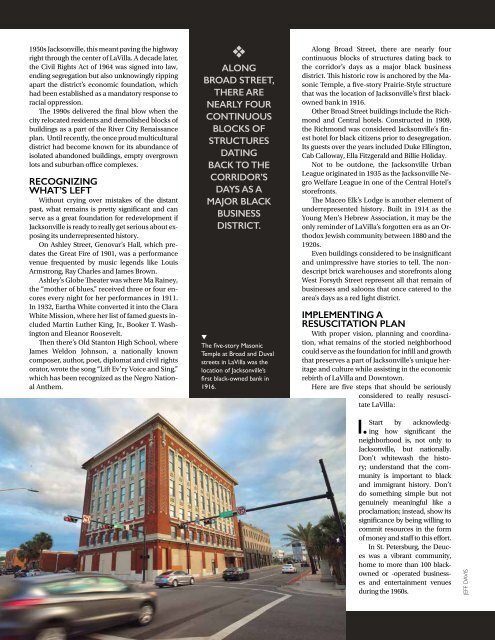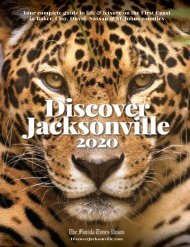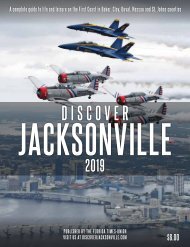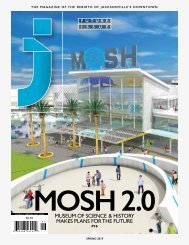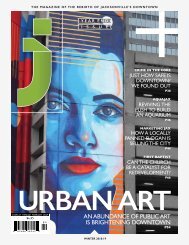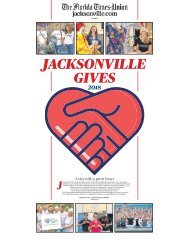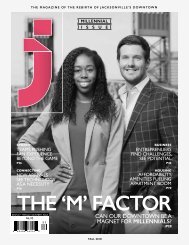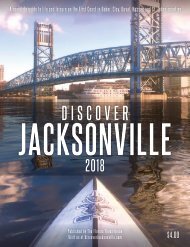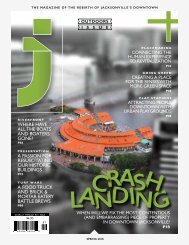J Magazine Summer 2018
The magazine of the rebirth of Jacksonville's downtown
The magazine of the rebirth of Jacksonville's downtown
You also want an ePaper? Increase the reach of your titles
YUMPU automatically turns print PDFs into web optimized ePapers that Google loves.
1950s Jacksonville, this meant paving the highway<br />
right through the center of LaVilla. A decade later,<br />
the Civil Rights Act of 1964 was signed into law,<br />
ending segregation but also unknowingly ripping<br />
apart the district’s economic foundation, which<br />
had been established as a mandatory response to<br />
racial oppression.<br />
The 1990s delivered the final blow when the<br />
city relocated residents and demolished blocks of<br />
buildings as a part of the River City Renaissance<br />
plan. Until recently, the once proud multicultural<br />
district had become known for its abundance of<br />
isolated abandoned buildings, empty overgrown<br />
lots and suburban office complexes.<br />
Recognizing<br />
what’s left<br />
Without crying over mistakes of the distant<br />
past, what remains is pretty significant and can<br />
serve as a great foundation for redevelopment if<br />
Jacksonville is ready to really get serious about exposing<br />
its underrepresented history.<br />
On Ashley Street, Genovar’s Hall, which predates<br />
the Great Fire of 1901, was a performance<br />
venue frequented by music legends like Louis<br />
Armstrong, Ray Charles and James Brown.<br />
Ashley’s Globe Theater was where Ma Rainey,<br />
the “mother of blues,” received three or four encores<br />
every night for her performances in 1911.<br />
In 1932, Eartha White converted it into the Clara<br />
White Mission, where her list of famed guests included<br />
Martin Luther King, Jr., Booker T. Washington<br />
and Eleanor Roosevelt.<br />
Then there’s Old Stanton High School, where<br />
James Weldon Johnson, a nationally known<br />
composer, author, poet, diplomat and civil rights<br />
orator, wrote the song “Lift Ev’ry Voice and Sing,”<br />
which has been recognized as the Negro National<br />
Anthem.<br />
v<br />
Along<br />
Broad Street,<br />
there are<br />
nearly four<br />
continuous<br />
blocks of<br />
structures<br />
dating<br />
back to the<br />
corridor’s<br />
days as a<br />
major black<br />
business<br />
district.<br />
t<br />
The five-story Masonic<br />
Temple at Broad and Duval<br />
streets in LaVilla was the<br />
location of Jacksonville’s<br />
first black-owned bank in<br />
1916.<br />
Along Broad Street, there are nearly four<br />
continuous blocks of structures dating back to<br />
the corridor’s days as a major black business<br />
district. This historic row is anchored by the Masonic<br />
Temple, a five-story Prairie-Style structure<br />
that was the location of Jacksonville’s first blackowned<br />
bank in 1916.<br />
Other Broad Street buildings include the Richmond<br />
and Central hotels. Constructed in 1909,<br />
the Richmond was considered Jacksonville’s finest<br />
hotel for black citizens prior to desegregation.<br />
Its guests over the years included Duke Ellington,<br />
Cab Calloway, Ella Fitzgerald and Billie Holiday.<br />
Not to be outdone, the Jacksonville Urban<br />
League originated in 1935 as the Jacksonville Negro<br />
Welfare League in one of the Central Hotel’s<br />
storefronts.<br />
The Maceo Elk’s Lodge is another element of<br />
underrepresented history. Built in 1914 as the<br />
Young Men’s Hebrew Association, it may be the<br />
only reminder of LaVilla’s forgotten era as an Orthodox<br />
Jewish community between 1880 and the<br />
1920s.<br />
Even buildings considered to be insignificant<br />
and unimpressive have stories to tell. The nondescript<br />
brick warehouses and storefronts along<br />
West Forsyth Street represent all that remain of<br />
businesses and saloons that once catered to the<br />
area’s days as a red light district.<br />
Implementing a<br />
resuscitation plan<br />
With proper vision, planning and coordination,<br />
what remains of the storied neighborhood<br />
could serve as the foundation for infill and growth<br />
that preserves a part of Jacksonville’s unique heritage<br />
and culture while assisting in the economic<br />
rebirth of LaVilla and Downtown.<br />
Here are five steps that should be seriously<br />
considered to really resuscitate<br />
LaVilla:<br />
Start by acknowledging<br />
how significant the 1.<br />
neighborhood is, not only to<br />
Jacksonville, but nationally.<br />
Don’t whitewash the history;<br />
understand that the community<br />
is important to black<br />
and immigrant history. Don’t<br />
do something simple but not<br />
genuinely meaningful like a<br />
proclamation; instead, show its<br />
significance by being willing to<br />
commit resources in the form<br />
of money and staff to this effort.<br />
In St. Petersburg, the Deuces<br />
was a vibrant community,<br />
home to more than 100 blackowned<br />
or -operated businesses<br />
and entertainment venues<br />
during the 1960s.<br />
JEFF DAVIS


